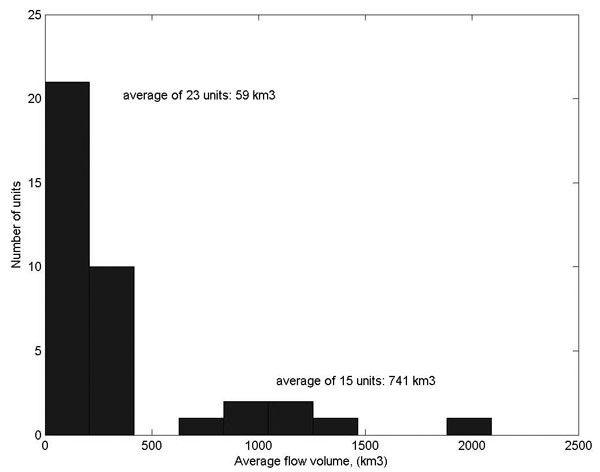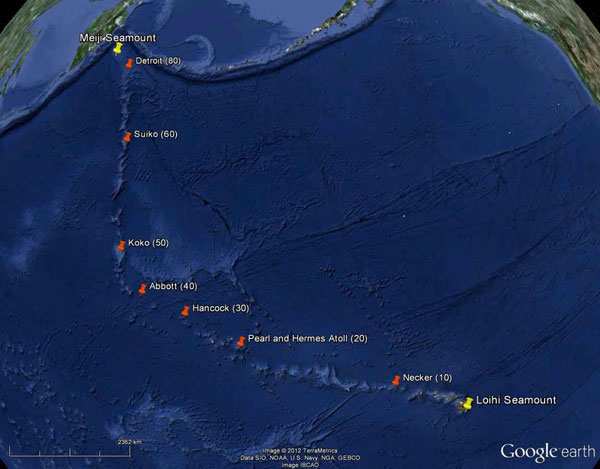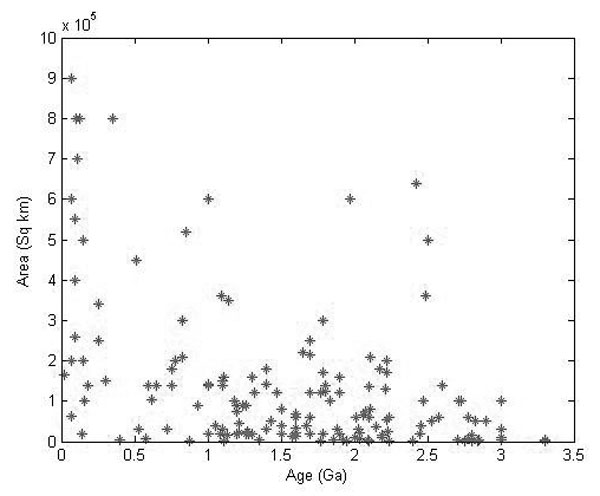 |
Definitions of Large Igneous Provinces |
Edgardo Cañón-Tapia
CICESE, Depto. de Geología, Carretera Ensenada-Tijuana No. 3918, Fraccionamiento Zona Playitas, Ensenada, Baja California, C.P. 22860, ecanon@cicese.mx
This webpage draws from the paper: Cañón-Tapia, E., 2010, Origin of Large
Igneous Provinces: The importance of a definition,
in Cañón-Tapia, E., and Szakács,
A., eds., What Is a Volcano?: Geological Society
of America Special Paper 470, p. 77–101,
doi: 10.1130/2010.2470(06).
Introduction
Large Igneous Provinces (LIPs) were defined more than a decade ago as “voluminous emplacements of predominantly mafic extrusive and intrusive rock whose origins lie in processes other than ‘normal’ seafloor spreading” (Coffin & Eldholm, 1992 – C&E). Ever since, LIPs have been almost unanimously considered to represent periods of anomalously high magma production rates and “to record periods when the outward transfer of material and energy from the Earth’s interior operated in a significantly different mode than at present” (Mahoney & Coffin, 1997b).
A second definition considers LIPs to be “provinces with areal extents > 0.1 Mkm2, igneous volumes > 0.1 Mkm3 and maximum life spans of ~50 Myr that have intraplate tectonic settings or geochemical affinities, and are characterized by igneous pulse(s) of short duration (~1 - 5 Myr), during which a large proportion (> 75%) of the total igneous volume was emplaced” (Bryan & Ernst, 2008 – B&E).
From the point of view of logic, the definitions of C&E and B&E are more closely related to each other than it would seem at first sight. Their similarities are easier to identify by focusing on the words in italics. In C&E, those words predispose us to look for “extraordinary” explanations for LIPs in exactly the same form as when saying “do not think of a white elephant” almost invariably brings to the mind an image of such an animal, even if briefly. In B&E, mention of a tectonic setting and a geochemical affinity favor the selective interpretation of observations from within the classification scheme closing the possibility of a diversity of independent LIP subtypes from the onset. Consequently, although following different paths, both C&E and B&E definitions bias our perception, opening the doors for mythical thinking.

Is this normal, or not?
The C&E and B&E definitions of a LIP include a hidden premise that constitutes an underlying issue in the debate about these provinces. Explicitly, such a premise is the a priori (i,e., by definition) relation with extraordinary behavior of the Earth’s interior during their formation. Actually, establishing what is “normal” and what is not is a rather difficult task for several reasons. For instance, almost every geoscientist would agree that at present there is no evidence suggesting that a LIP is forming anywhere in the world. Based in such observation, we might conclude that the present situation represents the “normal” case. Nevertheless, it is equally valid to assume that the scenario leading to the formation of LIPs is the normal situation, and that we are nowadays passing through a time of “abnormal” activity. This would be suggested by the fact that LIPs have been fairly common throughout Earth’s history when regarded as a group and not on a one-to-one basis (see references in Ernst et al., 2005; Macdougall, 1988a; Mahoney & Coffin, 1997a). Other arguments can additionally be used to support either the normality or abnormality of the processes that generate LIPs, all of which depend on the frame of reference being used.
Consequently, to avoid the use of hidden premises causing biases on the study of LIPs, their definition must avoid use of terms referring to “normal” and “extraordinary” or “abnormal” events. In this form, the current classification scheme simply would serve to divide the spectrum of volcanic provinces in two groups: LIPs (abnormal) and non-LIPs (normal), that may or may not be related to the same, or different genetic processes. The task then becomes to find a different classification scheme that can favor the identification of the assumed different genetic processes controlling the formation of each group. Alternatively, we need to devise a chain of cause-effect events in which specific (non-genetic) parameters can be used to explain the large differences defined by extreme end-products in the spectrum formed by all types of volcanic activity. In other words, we need to be able to explain why the same series of events sometimes leads to very-small-volume eruptions and sometimes to eruptions many orders of magnitude larger.
Observations and inferences about LIPs and non-LIPs
To avoid the usual fallacies it is necessary to be sure that we are dealing with the same number of premises in each case, and that the syllogisms associated with each independent piece of evidence are all equally valid. The most common parameters used to define LIPs, need to be examined with this in mind.
Proportion of extrusive vs. intrusive rocks
Sheth (2007) uses this parameter as a foundation to establish his hierarchical classification. Alternatively, Bryan & Ernst (2008) only use it to distinguish different types of provinces that they place at the same hierarchical level. A hierarchical classification that explicitly distinguishes between predominantly extrusive and predominantly intrusive LIPs provides a natural breakpoint in the continuum of volcano-magmatic activity. Consequently, this criterion seems to be well justified as an integral part of the classification scheme of LIPs, making the approach of Sheth (2007) slightly better than that of B&E, from the point of view of logic.
Size
One of the most striking aspects of LIPs is their apparently larger size relative to non-LIP volcanic provinces. Debates have occurred along two main issues.
1. Is it more appropriate to use volume of erupted products than area covered, to characterize the size of a volcanic province?
The area covered by some erupted products might depend strongly on factors such as prior topography, vent distribution, viscosity of the magma, mechanism of growth of the products (endogenous vs. exogenous), and rate of eruption. Topography and vent distribution are also likely to influence estimates of the volumes of igneous rocks. Furthermore, it is easier to relate the volume of igneous rocks (directly or indirectly) to the amount of magma produced in a region of the mantle, than it is to relate eruptive area. The size of the mantle source volume is interesting because it is likely to contain information about the genesis of those provinces. Thus, it seems that volume is a more useful characterization of the size of a province than the area. Other reasons to prefer volume over area have been discussed elsewhere (Bryan & Ernst, 2008). Unfortunately, the widespread use of this parameter is precluded because the information is available for a few provinces only. For example, most of the provinces included in the database of the Large Igneous Provinces Commission (www.largeigneousprovinces.org) lack a volume estimate. As a result, identification of significant breakpoints in the range of volume of volcanic provinces would seem premature. It should also be noted that some of the volume estimates are speculative, especially where they are based in indirect observation, e.g., using geophysics. An example of the dangers of using volume without additional controls concerning the age of the products is given below.
2. What is the numerical threshold of area or volume that can be used to divide LIPs from non-LIPs?
From the point of view of logic, selection of a particular threshold to divide LIPs from non-LIPs is either done arbitrarily (imposed “by definition”), or it is relatively irrelevant because it can be adjusted to accommodate any breakpoint apparent in the database at the time of examination. The only point to note is that once a threshold is selected, any province below that value becomes “by definition” a non-LIP, and any province above that value becomes “by definition” a LIP. On the other hand, given enough time almost any volcanic province might reach a given cumulative area (or volume), and consequently change from being a non-LIP to becoming a LIP. For these reasons, the use of an area or volume threshold will not lead to any fallacious argument, although it might foster circular reasoning if used injudiciously.
Whole provinces vs. isolated eruptive events
Commonly, the size of a whole province is studied to decide whether it might be a LIP or not. Nevertheless, we might also consider examining the products of single eruptive events. To illustrate this point we might examine information gathered from Continental Flood Basalts (CFBs) as representative of LIPs. For the case of a typical modern volcanic province, the volume of extruded magma during a single event may be < ~ 0.5 km3, with a typical upper limit the volume extruded during an eruption with a volcanic explosivity index of VEI ~5. Nevertheless, although it occurs only rarely, the volumes extruded might be much larger, as exemplified by the 15 km3 Laki, Iceland flow of 1783 (Pyle, 2000). In the case of CFBs, the volumes of single extrusion events are also variable, as has been shown for the Columbia River Basalt Province (Tolan et al., 1989). These data (Figure 1) show that most single eruptive events involved relatively small volumes of magma, with a mean value of ~ 60 km3. Larger events (~750 km3) are also been documented, though they occur only rarely. The data show that even fewer events have record volumes exceeding 2000 km3. Thus, a difference in volume of two to three orders of magnitude might distinguish LIPs from non-LIPs on the scale of individual eruptions. Thus, a difference of two to three orders of magnitude might seem to distinguish LIPs from non-LIPs at the scale of the volume of individual eruptions. Whether this difference is relevant in a genetic context or not is a completely different question.

Figure 1: Histogram of volumes of individual lava flows in the CRB.
Time
As in the case of size, there are alternative forms in which time can be considered to be important in the classification of volcanic provinces.
Absolute Age
From the point of view of a classification scheme, the age of a province can only be important to the extent that it could be claimed that there is at least one breakpoint in time marking the formation of LIPs and non-LIPs. Even in that case, this particular parameter would share the same problems as selection of a size threshold. Although the exercise has not been done (perhaps it should be), it seems improbable that it would be found that volcanic activity took place around the world exclusively within either the LIP or non-LIP categories during a given time period. Most probably, both types of activity occurred simultaneously therefore reducing the relevance of absolute age in an unbiased classification scheme of volcanic provinces. Nevertheless, absolute age might be used to establish a cause-effect relationship with other events whose age can be documented independently. In the context of LIPs, those events include specific exogenic or terrestrial forcing processes, or mass extinctions (see references in Ernst et al., 2005).
Duration of Activity
Let us examine the case of the Hawaiian-Emperor seamount chain in detail, to understand the role played by an arbitrary (a priori) constraint on the longevity of activity that builds a volcanic provinc (Figure 2). This chain can be considered to be a LIP if the size of the whole chain is considered, but this requires inclusion of the Meiji seamount that was erupted over 80 Myr ago, and possibly even more than 100 Myr (Scholl & Rea, 2002). Since such a time frame is large, the classification of this chain as a LIP might be thought by many to be surprising.

Figure 2: The Hawaiian-Emperor seamount chain (bounded by yellow markers) and selected seamounts and islands with approximate ages in Ma shown in parenthesis. Click here or on Figure for enlargement.
If an arbitrary, and shorter threshold in the duration of activity is introduced, it is necessary to split the chain into LIP and non-LIP parts. For instance, if the seamount chain is arbitrarily split into time intervals of 10 Myr each we would conclude that the most recent LIP in the chain is the most productive, which in turn leads to another series of problems concerning the presumed plume head and tail production, as already discussed by Foulger (2007). An alternative would be to consider the time-scale associated with the formation of one individual island (say, ~ 1 Ma), since this period is likely to contain a significant pulse of volcano magmatic activity. In that case, none of the islands in the chain would justify the status of a LIP because both the area and volume of single islands are about one order of magnitude smaller than even the lowest thresholds claimed for LIPs.
Consequently, use of the parameter “duration of activity” might lead to various different conclusions, all of which are entirely arbitrary, having being defined a priori. Consequently, this parameter might promote fallacies, and care must be exercised when including it in any definition.
Whole provinces vs. eruptive events
As for the case of size, time scales might be applied to the formation of a whole province or to individual events. In the first case, we often include in our estimations the oldest and youngest available radiometric ages from one particular province. Exclusive use of radiometric dates, however, implies neglecting information from stratigraphic or morphologic studies that suggest that extremely long periods of quiescence have occurred in at least some CFB provinces (Jerram & Widdowson, 2005). Therefore, by adopting solely the radiometric age range we risk grossly underestimating the period of activity and obtaining a very wrong representation of real processes occurring in the province.
Alternatively, we might estimate the duration of one eruptive event, and by using other sources of information assess typical quiescence times. This approach suffers from a practical problem, however, because we lack the resolution power to date radiometrically, with the required accuracy, the products of single eruptive events. Since obtaining an accurate estimate of the duration of any single eruption observed in the geologic record is essentially impossible at present, this time-frame is not recommended as the basis of a hierarchical LIP classification.
Age and Size
Size progression with time
Although Figure 3 excludes a few LIPs larger than 105 km2, their exclusion does not alter the fact that there is a clear absence of any pattern. Neither does the fact that the ages used in Figure * were always the oldest in the database modify this conclusion, because some of the reported age ranges are very small relative to the total age scale of the figure. Thus, at least at present, there is no link between size and progression with time, and therefore the combination of these variables is not significant in a genetic context.

Figure 3: Age versus area of LIPs.
Time restrictions to size
Another example illustrating the dangers of extrapolating information from two different sources, is provided by the case of the Okavango dyke swarm in Botswana. The size of this dyke swarm, as suggested by geophysical means, justifies its classification as a LIP. However, Jourdan et al. (2004) showed that the whole feature comprises two populations of dykes with very different radiometric ages. The younger, Lower Jurassic dykes, were emplaced along a reactivated zone of lithospheric weakness marked by the older, Proterozoic dykes. Clearly, the combined volume of all the dykes is an overestimate of the volume of magma that might reasonably be considered to represent a single LIP. Examining size in the absence of extensive age information can lead to unjustified extrapolations.
Speed of emplacement
Although available evidence might seem to support the notion that LIPs are characterized by eruption of relatively large volumes of magma in short periods of time, the rate of eruption of individual events in these provinces might have been not much different from the rate of eruption of events in other provinces. For example, the extrusion rate of the Laki, Iceland eruption of 1783 - 1785 may have peaked at ~ 8.7 x 103 m3/s (Thordarson & Self, 1993). This value is equivalent to more than 274 km3/yr, which is comparable to even the highest extrusion rates in the most productive LIPs. Also, from a morphological point of view, although a large variety of volcanic styles and architectures are found in CFBs, pahoehoe flows are not uncommon in these provinces (Jerram & Widdowson, 2005). This type of flow is favored if eruption rates are < 100 m3/s (Griffiths & Fink, 1992), equivalent to just 3.2 km3/yr and corresponding to the higher end of the range typical of modern volcanic provinces. Finally, the rate of arrival of magma to the crust in CFBs may be similar to mid-ocean spreading ridges when large enough time intervals are considered (Macdougall, 1988b; Thompson, 1977). Dismissing these results without further examination because they do not fit the expected characteristics of a LIP is typical of mythical thinking. To avoid the fallacies associated with this confusion of terms, the term “rapidity of emplacement” should be restricted to the whole province without extrapolating to individual events. Also, the possibility that eruption rates are relatively uniform in all igneous provinces is a clue that could be significant in considering genetic models.
Other problems associated with terms such as magma production rate are discussed here.
Tectonic Setting
Some LIPs were emplaced near the edges of Archean cratons (Anderson, 1994), but these regions may have undergone extension prior to LIP emplacement. Determining whether such extension was the cause of the LIP or vice versa has been one of the most debated subjects in LIP literature over the years (Sheth, 1999a; 1999b). As noted by Bryan & Ernst (2008), “an intraplate tectonic setting is particularly problematic for the Cenozoic LIPs of North America”, yet the status of LIP for those provinces was granted due to their large extent and rapidity of eruption. Consequently, an intra-plate or tectonic setting for volcanism apparently accords special status in the LIP-definition process.
Geochemical Composition
Although there is a common perception that LIPs are remarkably homogeneous, detailed examination reveals significant compositional variation, both spatial and temporal (e.g., Jerram & Widdowson, 2005). Associating a “distinctive intraplate geochemical signature” to any rock type might involve a significant amount of circular reasoning (Anderson, 2000), which is another type of fallacious argument. If the definition of a LIP is to be useful and provide an unbiased grouping of common features to identify real patterns or trends, it is better to avoid including the geochemistry of the rocks as a critical argument.
How Many Parameters Are Needed for a Significant Classification of LIPs?
The discussion presented here shows that distinction between the intrusive and the extrusive components of a LIP is an important criterion that can help avoid fallacies in the interpretation of other characteristics of these volcanic provinces. Consequently, the first hierarchical level of the classification scheme proposed by Sheth (2007) seems justified. Two other parameters that need to be included in the definition of LIPs are size (area or volume) and time. These two parameters need to be considered simultaneously in order to make a useful discrimination between LIP and non-LIP activity. Nevertheless, “rapidity of emplacement” is an ambiguous term that can be interpreted in various ways, each leading to different interpretations. The more useful of these interpretations is when this parameter is used to describe the time of emplacement of a single extrusive province.
Consequently, size, duration of activity and the resulting rate of emplacement might be useful at present to distinguish LIPs from non-LIPs only broadly, but unhelpful for finer hierarchical classifications.
Other criteria (age, crustal and tectonic settings and the dominant composition of the rocks in the province) do not seem helpful. Actually, these parameters might encourage fallacious arguments, and consequently they should not comprise critical elements of the definition of a LIP.
Bibliography
-
Anderson, D.L., 1994. Superplumes or supercontinents? Geology, 22: 39 - 42.
-
Anderson, D.L., 2000. The satatistics and distribution of helium in the mantle. International Geological Reviews, 42: 289 - 311.
-
Bryan, S.E. and Ernst, R.E., 2008. Revised definition of Large Igneous Provinces (LIPs). Earth Science Reviews, 86: 175 - 202.
-
Coffin, M.F. and Eldholm, O., 1992. Volcanism and continental break-up: a global compilation of large igneous provinces. In: B. Storey, C., T. Alabaster and R. Pankhurst, J. (Editors), Magmatism and the causes of continental break-up. The Geological Society, London, pp. 17 - 30.
-
Ernst, R.E., Buchan, K.L. and Campbell, I.H., 2005. Frontiers in Large Igneous Province research. Lithos, 79: 271 - 297.
-
Foulger, G.R., 2007. The 'Plate' model for the genesis of melting anomalies. In: G. Foulger and D. Jurdy (Editors), Plates, Plumes, and Planetary Processes. Geological Society of America, pp. 1 - 28.
-
Griffiths, R.W. and Fink, J.H., 1992. Solidification and morphology of submarine lavas: a dependence on extrusion rate. Journal of Geophysical Research, 97: 19 729 - 19 737.
-
Jerram, D.A. and Widdowson, M., 2005. The anatomy of Continental Flood Basalt Provinces: geological constraints on the processes and products of flood volcanism. Lithos, 79: 385 - 405.
-
Jourdan, F. et al., 2004. The Karoo triple junction questioned: evidence from Jurassic and Proterozoic 40Ar/39Ar ages and geochemistry of the giant Okavango dyke swarm (Botswana). Earth and Planetary Science Letters, 222: 989 - 1006.
-
Macdougall, J.D., 1988. Continental flood basalts and MORB: A brief discussion of similarities and differences in their petrogenesis. In: J. MacDougall, D. (Editor), Continental Flood Basalts. Kluwer Academic Publishers, Dordrecht, pp. 331 - 341.
-
Mahoney, J.J. and Coffin, M.F. (Editors), 1997a. Large Igneous Provinces, Geophysical Monograph 100. American Geophysical Union, Washington, D.C., 438 pp.
-
Mahoney, J.J. and Coffin, M.F., 1997b. Preface. In: J. Mahoney, J. and M. Coffin, F. (Editors), Large igneous provinces. Continental, oceanic, and planetary flood volcanism. AGU, Washington D.C., pp. ix - x.
-
Pyle, D.M., 2000. Sizes of volcanic eruptions. In: H. Sigurdsson, B. Houghton, F., S. McNutt, R., H. Rymer and J. Stix (Editors), Enciclopedia of volcanoes. Academic Press, San Diego, pp. 263 - 269.
-
Scholl, D.W. and Rea, D.K., 2002. Estimating the age of the Hawaiian hotspot, AGU Fall meeting, San Francisco, CA, pp. abstract # T61C-05.
-
Sheth, H.C., 1999a. Flood basalts and large igneous provinces from deep mantle plumes: fact, fiction, and fallacy. Tectonophysics, 311: 1 - 29.
-
Sheth, H.C., 1999b. A historical approach to continental flood volcanism: insights into pre-volcanic rifting, sedimentation, and early alkaline magmatism. Earth and Planetary Science Letters, 168: 19 - 26.
-
Sheth, H.C., 2007. 'Large Igneous Provinces (LIPs)': Definition, recommended terminology, and a hierarchical classification. Earth Science Reviews, 85: 117 - 124.
-
Thompson, R.N., 1977. Columbia/Snake River - Yellowstone magmatism in the context of western U.S.A. Cenozoic geodynamics. Tectonophysics, 39: 621 - 636.
-
Thordarson, T. and Self, S., 1993. The Laki (Skaftár Fires) and Grímsvötn eruptions in 1783 - 1785. Bulletin of Volcanology, 55: 233 - 263.
-
Tolan, T.L. et al., 1989. Revisions to the estimates of the areal extent and volume of the Columbia River Basalt Group. In: S. Reidel, P. and P. Hooper, R. (Editors), Volcanism and tectonism in the Columbia River flood-basalt province. Geological Society of America, Boulder, pp. 1 - 20.
last updated 28th
October, 2012 |
